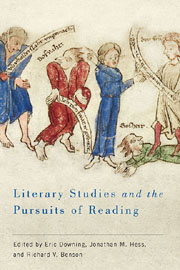Book contents
- Frontmatter
- Contents
- List of Illustrations
- Introduction
- Part I Medieval and Early Modern Practices of Reading
- 1 Apertio Libri: Codex and Conversion
- 2 The Question of Reading and the Medieval Book: Reception and Manuscript Variation of Thomasin's Welscher Gast
- 3 Reading in Nuremberg's Fifteenth-Century Carnival Plays
- 4 Shakespeare, Biblical Interpretation, and the Elusiveness of Meaning
- Part II Reading, Secularization, and Transcendence in the Long Nineteenth Century
- Part III Theories and Practices of Reading in the Twentieth Century and Beyond
- Part IV Postscript: The Ends of Reading
- Works Cited
- Notes on the Contributors
- Index
3 - Reading in Nuremberg's Fifteenth-Century Carnival Plays
from Part I - Medieval and Early Modern Practices of Reading
Published online by Cambridge University Press: 05 February 2013
- Frontmatter
- Contents
- List of Illustrations
- Introduction
- Part I Medieval and Early Modern Practices of Reading
- 1 Apertio Libri: Codex and Conversion
- 2 The Question of Reading and the Medieval Book: Reception and Manuscript Variation of Thomasin's Welscher Gast
- 3 Reading in Nuremberg's Fifteenth-Century Carnival Plays
- 4 Shakespeare, Biblical Interpretation, and the Elusiveness of Meaning
- Part II Reading, Secularization, and Transcendence in the Long Nineteenth Century
- Part III Theories and Practices of Reading in the Twentieth Century and Beyond
- Part IV Postscript: The Ends of Reading
- Works Cited
- Notes on the Contributors
- Index
Summary
The fifteenth-century Nuremberg carnival plays—short, skit-like, rhymed couplet texts written in German and largely treating secular themes—present new and rich opportunities to explore the nature and practice of reading in the late medieval world. Defining reading first as the visual processing and mental decoding of letters on a page allows this essay to glance briefly at some of the notions of reading implicit in the manuscript transmission itself, and to examine the motif of reading in the plays. We will see that while the motif of reading books and letters is not uncommon in medieval German literature from the 1200s on, it is virtually absent from the Nuremberg carnival plays, where it is alluded to only occasionally. That this should be so in a city enjoying high rates of literacy and renowned for its cultivation of literature leads us to further exploration of the plays based on a second definition of reading as interpretation broadly construed, in Dennis H. Green's formulation “the reading of signs where no actual writing is involved and where the reader is to pass from an external indicator to the concealed meaning.” This expanded definition allows us to explore the ways in which the plays make their comic points by participating in and staging a broad and surprising spectrum of medieval interpretive practices: personification; medical diagnosis; character diagnosis using four humors theory; mental arithmetic (Kopfrechnen); and, finally, imaginative or performative visualization, a technique widely discussed in connection with medieval religious and devotional practice but less well studied in the realm of secular, comic literature.
- Type
- Chapter
- Information
- Literary Studies and the Pursuits of Reading , pp. 68 - 83Publisher: Boydell & BrewerPrint publication year: 2012



